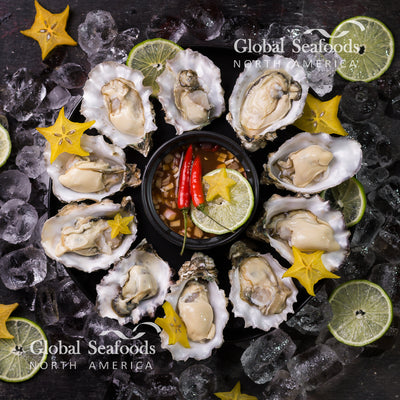Oyster Restoration Projects: How They Work and Why They Matter

Oyster Restoration Projects
Oyster restoration projects have become a cornerstone of marine conservation, aiming to rebuild dwindling oyster populations and their habitats. Beyond their culinary appeal, oysters play an essential role in maintaining marine ecosystems. This article delves into how restoration projects work, their ecological benefits, and ways you can support these vital initiatives.
For fresh, sustainably sourced oysters, visit the Global Seafoods Oysters Collection.
Why Are Oysters So Important?
Oysters are more than just a seafood delicacy—they’re environmental powerhouses:
- Natural Water Filtration: A single oyster can filter up to 50 gallons of water per day, removing sediments, algae, and pollutants.
- Habitat Formation: Oyster reefs provide shelter and breeding grounds for fish, crabs, and other marine species.
- Coastal Protection: Oyster reefs act as natural barriers, reducing wave energy and preventing shoreline erosion.
Their decline has far-reaching consequences for marine ecosystems and coastal communities, making restoration projects essential.
What Are Oyster Restoration Projects?
Oyster restoration projects aim to rebuild oyster populations and habitats through scientific and community-driven efforts. These projects involve planting oyster seeds, constructing artificial reefs, and protecting existing oyster beds to promote natural growth.
Key Goals of Oyster Restoration Projects:
- Enhance water quality.
- Restore biodiversity.
- Support sustainable seafood production.
- Protect coastal areas from erosion.
Learn more about oysters and their environmental role at Global Seafoods.
How Do Oyster Restoration Projects Work?
1. Collecting and Recycling Oyster Shells
Oyster shells are a crucial resource for restoration. Many projects collect discarded shells from restaurants and seafood markets to use as a foundation for new reefs.
- Process: The shells are cleaned, cured, and placed in areas where oyster larvae can attach and grow.
- Fun Fact: It’s estimated that recycled oyster shells can provide homes for thousands of new oysters!
2. Planting Oyster Seeds
Oyster larvae (called spat) are cultivated in hatcheries and then released onto prepared reefs. These larvae attach to shells or other substrates, beginning their growth into mature oysters.
3. Constructing Artificial Reefs
In areas where natural oyster beds have been destroyed, artificial reefs made from concrete, limestone, or recycled shells are installed to provide a stable habitat for oysters and marine life.
4. Protecting Existing Oyster Beds
Many projects involve creating no-harvest zones to allow wild oyster populations to recover and thrive.
5. Community Involvement
Local communities often play a vital role in restoration projects, volunteering to collect shells, plant seeds, or monitor water quality.
For premium-quality oysters perfect for supporting sustainable practices, check out Maine Oysters.
The Benefits of Oyster Restoration Projects
Oyster restoration projects offer ecological, economic, and social benefits:
1. Improved Water Quality
By filtering algae, sediments, and pollutants, oysters improve water clarity and promote healthier ecosystems.
2. Biodiversity Boost
Restored reefs support diverse marine life, providing habitat for species like shrimp, crabs, and fish.
3. Coastal Protection
Oyster reefs absorb wave energy, reducing erosion and protecting coastal communities from storm surges.
4. Economic Opportunities
Restoration efforts create jobs in aquaculture, reef construction, and monitoring. They also support the seafood industry by ensuring sustainable oyster populations.
5. Climate Resilience
Healthy oyster reefs store carbon and mitigate the effects of climate change on coastal ecosystems.
Successful Oyster Restoration Projects Worldwide
-
Chesapeake Bay, USA:
The Chesapeake Bay Foundation has planted over 14 billion oysters since the 1990s, making it one of the largest restoration efforts globally. -
Australia:
The South Australian government is building the world’s largest oyster reef restoration project, covering 20 hectares. -
New York Harbor, USA:
The Billion Oyster Project aims to restore 1 billion oysters to New York Harbor by 2035, engaging local communities and schools in the process.
For oysters that support sustainability, try Tidepoint Oysters.
How You Can Support Oyster Restoration Efforts
- Recycle Oyster Shells: Participate in shell recycling programs if available in your area.
- Choose Sustainably Farmed Oysters: Opt for oysters from responsible sources like Global Seafoods.
- Volunteer: Join local restoration projects to help plant oyster seeds or monitor reefs.
- Spread Awareness: Share information about the importance of oyster restoration with friends and family.
FAQs About Oyster Restoration Projects
1. Are restored oysters safe to eat?
Yes, oysters grown in restoration projects are often monitored for safety and quality, making them safe for consumption.
2. How long does it take for an oyster reef to grow?
Oyster reefs can begin showing results within 2–3 years, but full restoration may take a decade or more.
3. Can oyster restoration help with climate change?
Yes, oyster reefs store carbon, reduce coastal erosion, and promote healthier marine ecosystems, mitigating some effects of climate change.
For more insights into oysters, check out the Global Seafoods YouTube Channel.
Top Picks from Global Seafoods
Discover high-quality oysters to enjoy while supporting sustainability:
Call to Action: Join the Movement for Oyster Restoration
Oyster restoration projects are vital for preserving marine ecosystems and ensuring sustainable seafood for future generations. By supporting these efforts, you can contribute to a healthier planet.
Shop Sustainable Oysters Today:
Also in News

How to Make Sea Bream Sushi With Dry-Aged Tuna & Crab Roll — Step-by-Step With Chef Joshua
A complete guide to making Sea Bream sushi at home, including filleting, curing, slicing, and building a Dry-Aged Tuna & Crab sushi roll. Chef Joshua shares professional tips for restaurant-quality results.

Boiled Crab for Game Night: Everything You Need for a Perfect Seafood Party
Take your game night to the next level with a Boiled crab party. Learn the best recipes, cooking tips, and hosting hacks for a memorable seafood feast.

Boiled Crab for Date Night: A Romantic Guide to the Perfect Seafood Feast
Make your next date night unforgettable with a romantic Boiled crab experience. This guide covers everything you need to know, from ambiance to the best crab varieties.






